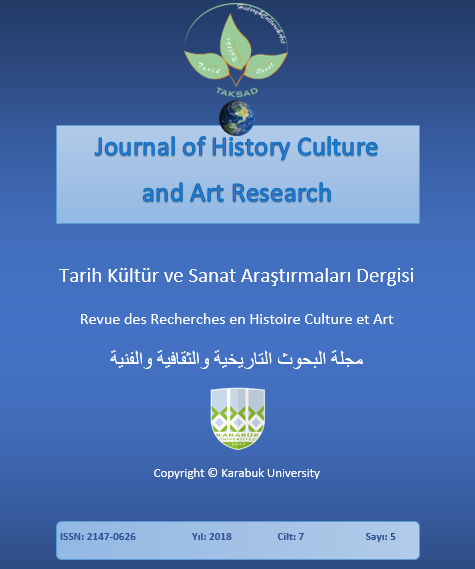Writer and Olonkho-Performer: Features of “Buura Dokhsun” Olonkho’s Verse by Erilik Eristiin
DOI:
https://doi.org/10.7596/taksad.v7i5.1915Keywords:
Folklore, Epic, Olonkho, Olonkho-performer, Versification, Poetic speech, Rhythm, Alliteration, Rhyme.Abstract
This article discusses the features of “Buura Dokhsun” Olonkho’s verse, first published in 1993 by Erilik Eristiin, writer and olonkho-performer. The introduction briefly refers to the studies of the past years, which revealed common features among folk storytellers. Similar moments are clearly shown in the composition of epics. Further, in detail described a special method for studying the verse of olonkho, proposed by professor N.N. Toburokov. This method has been used for about ten years to study many texts of the epic work of the Sakha people. To familiarize in the beginning is given a brief biographical note about the author, about the work as a whole. For the first time are studied the rhythm, alliteration, rhyme of olonkho by writer and olonkho performer – Semen Stepanovich Yakovlev – Erilik Eristiin. It is revealed that in the olonkho “Buura Dokhsun” he followed the canons of the Yakut heroic epic, but in comparison with genuinely folk storytellers, the formal parameters of the Olonkho’s verse are much higher. So, in the epic “Buura Dokhsun” alliteration in the beginning of a line (from the studied 1543 lines) makes 70,7%, and inside of a line makes 26,7%. The peculiarity of the olonkho’s verse by poet-storyteller is the fact that the number of rhythmic structures that are exactly repeated in the next or corresponding other line has increased to 40%, whereas we found that in the epics of M. N. Androsova-Ionova they are 10%, and D. Govorov – 5%. The use of rhyme by Erilik Eristiin is also higher – in average 73%, and the average rate in traditional storytellers – 56%, there is also a masterful use of different forms of phonomorphological rhymes. At the end of the article the results are summarized. In general, Erilik Eristiin, maintaining the common traditional forms of the verse of the folk epic, introduced a lot of new, inspired by his own poetic experience. The writer and Olonkho-performer Erilik Eristiin has other manuscripts of Olonkho. In this respect, he is the only writer who has created so many Olonkho.
References
Arkhipova, E. A. (2018). Peculiarities of the verse in T. Zakharov – Chaaby’s “Ala-Bulkun” olonkho. Vestnik of Notrh-Eastern Federal University: Series Epic studies, No. 1(9), 90-99. doi: 10.25587/SVFU.2018.9.11686
Dyachkovskaya, M. N. (1998). Alliteration and rhyme in Yakut poetry. Problems of evolution and classification. Novosibirsk: Nauka.
Erilik Eristiin (1993). Buura Dokhsun: Olonkho. Yakutsk: Bichik.
Illarionov, V. V. (2006). Magic world of Olonkho. Yakutsk: Bichik.
Memoirs about Erilik Eristiin (1992). Yakutsk: Book publishing house.
Olonkhosuts of Yakutia: a Handbook (2013). Yakutsk: Publishing house of the NEFU.
Shcherbak, A. M. (1961). Correlation of alliteration and rhyme in Turkic versification. Peoples of Asia and Africa, No. 2, 142-153. Toburokov, N. N. (1963). Erilik Eristiin. Yakutsk: Book printing house.
Toburokov, N. N. (1979). Writer of Korchagin School. Yakutsk: Book publishing house.
Toburokov, N. N. (1992). Erilik Eristiin. Churapcha: Regional printing house.
Toburokov, N. N. & Arkhipova, E. A. (2009). Sources of the Yakut verse in “Olonkho” by A. Uvarovsky. Vestnik YaSu, Vol. 6, No. 2, 89-91.
Vasilyev, G. M. (1965). Yakut versification. Yakutsk: Yakutsk book publishing house.
Writers of the Olonkho land: bio-bibliographic directory. (2000). Yakutsk: Bichik.
Downloads
Published
How to Cite
Issue
Section
License
All papers licensed under Creative Commons 4.0 CC-BY.- Share — copy and redistribute the material in any medium or format
- Adapt — remix, transform, and build upon the material for any purpose, even commercially.
Under the following terms:
Attribution — You must give appropriate credit, provide a link to the license, and indicate if changes were made. You may do so in any reasonable manner, but not in any way that suggests the licensor endorses you or your use.
- No additional restrictions — You may not apply legal terms or technological measures that legally restrict others from doing anything the license permits.







